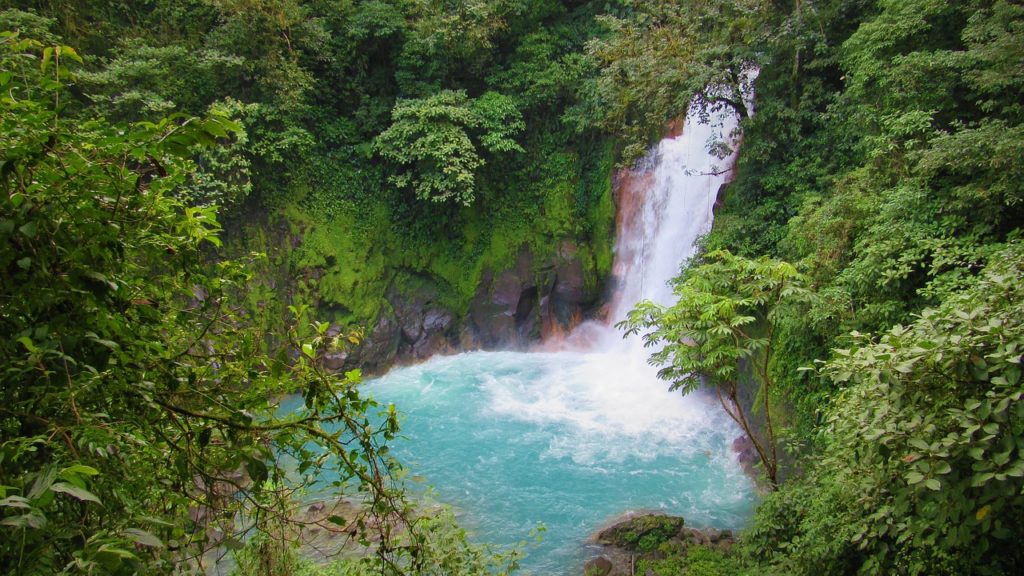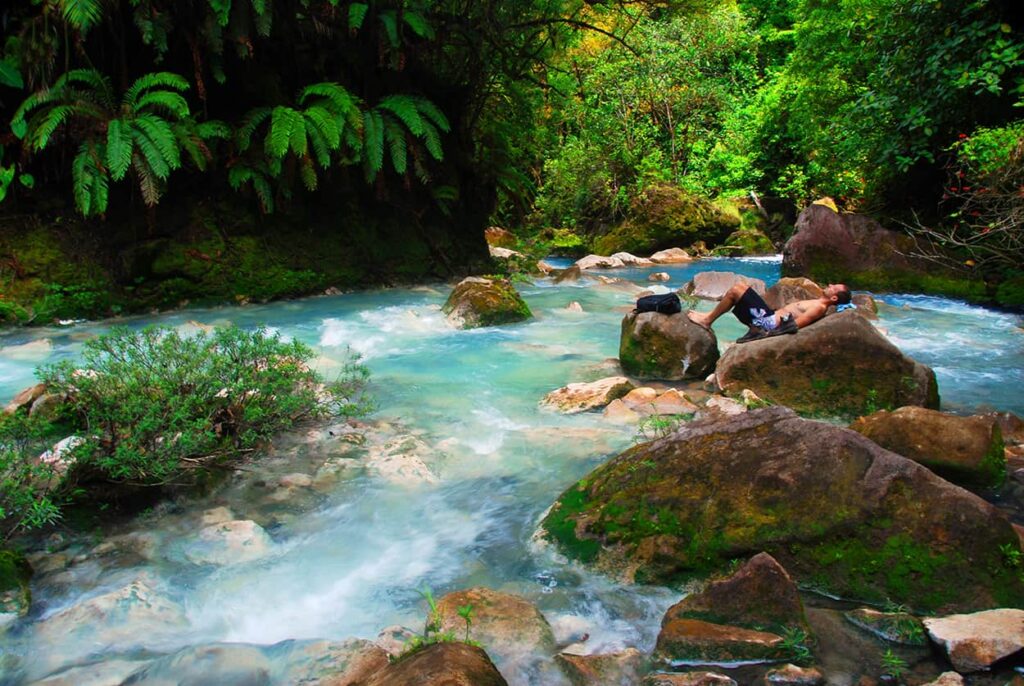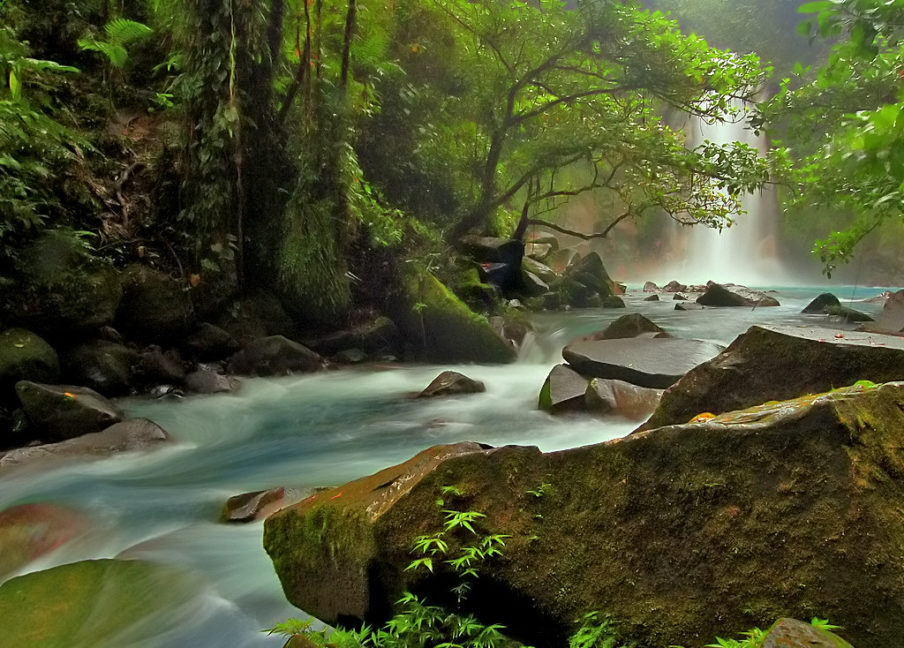
Rio Celeste is in the Tenorio Volcano National Park, is a popular natural attraction in Costa Rica. Its turquoise river, colored by a rare mineral mix, draws visitors to its breathtaking waterfall and surrounding rainforest trails. This guide covers everything you need to plan your trip, including how to get there, top activities, and practical tips.
What Makes Rio Celeste Special?
The turquoise waters of Rio Celeste set it apart as one of Costa Rica’s most striking natural wonders, with a unique origin story and vibrant surroundings. The river’s vivid blue stems from a natural phenomenon at El Teñidero, where two clear rivers—Rio Buenavista and Quebrada Agria—meet. Minerals like aluminum, silicon, and oxygen create a light-scattering effect, producing the river’s striking color.
A local legend claims God rinsed his paintbrush in the river after painting the sky. The waterfall, dropping 98 feet into a glowing pool, is the park’s highlight, complemented by rainforest trails, hot springs, and diverse wildlife.
Getting to Rio Celeste
Reaching Rio Celeste requires some planning, but the drive through Costa Rica’s northern countryside is straightforward with the right directions. Tenorio Volcano National Park lies in northern Costa Rica, spanning Guanacaste and Alajuela provinces. Driving is the most reliable way to reach it, as public transportation is limited. Below are directions from two major starting points:
- From Liberia: Take Route 21 east toward Upala for 48 km, then turn left onto Route 6 for 19 km. Turn right onto Route 4 for 9 km, then left onto Route 794 for 13 km. Follow the park’s entrance road for 8 km to the parking lot. Total distance: ~95 km. Driving time: 1.5–2 hours. The final stretch may be rough, so a 4×4 vehicle is recommended during the rainy season (May–December).
- From San Jose: Drive north on Route 1 toward Cañas, then take Route 6 toward Bijagua for about 45 km. Follow signs to the park entrance. Total distance: ~180 km. Driving time: 3.5–4 hours. Roads are narrow and winding, so travel during daylight and refuel beforehand.
Parking costs 2,000 CRC (~$4). Tickets are purchased online through the SINAC website ($12 for non-residents, $5 for children aged 2–12). No ticket booth is available at the entrance, and cell service is unreliable, so buy tickets in advance.
Things to Do at Rio Celeste

From hiking to cultural experiences, Rio Celeste offers a range of activities to explore the park’s natural and cultural highlights. Below are the top options for visitors.
Hike to the Waterfall
The waterfall is Rio Celeste’s main draw, and the trail to reach it offers a rewarding hike through the rainforest. The Rio Celeste Trail, a 6 km round-trip hike, takes 3–4 hours and leads to the waterfall. The trail is moderately challenging, with 254 steep steps to the viewpoint. It’s well-maintained but can be muddy, so wear sturdy hiking shoes. Swimming is prohibited to preserve the ecosystem. The dry season (December–April) offers the clearest water and most vibrant blue.
Explore Other Trails
Beyond the main waterfall trail, the park has additional paths that showcase its diverse terrain and wildlife. Options include:
- Mirador Trail: A 3 km round-trip hike to a viewpoint of Tenorio Volcano and Cerro Montezuma. Takes about 2 hours. Difficulty: Easy.
- Puma Trail: A 13 km round-trip trek through dense rainforest, perfect for spotting monkeys or sloths. Takes 6–7 hours. Difficulty: Hard.
- Waterfall Trail: A 1.6 km loop to smaller waterfalls along the river. Takes 1–2 hours. Difficulty: Easy.
Soak in Hot Springs
After a day of hiking, the park’s geothermal pools provide a relaxing retreat surrounded by nature. Natural hot springs, such as Los Borbollones, offer a geothermal experience. They’re accessible via a short hike from the park entrance. Visit early to avoid crowds. No towels or lockers are provided.
Birdwatching
The park’s rich ecosystem makes it a haven for bird enthusiasts, with opportunities to spot colorful species. The park hosts over 540 bird species, including toucans, trogons, and tanagers. The Puma Trail is ideal for birdwatching. A guide can help identify species. Bring binoculars and wear neutral-colored clothing to avoid startling birds.
Visit the Maleku Reserve
Just outside the park, the Maleku community offers a chance to engage with Costa Rica’s indigenous heritage. The Maleku Indigenous Reserve provides cultural tours, basket weaving, pottery, and a museum showcasing traditional artifacts. Guided tours highlight medicinal plants and wildlife. Advance booking is recommended.
Practical Information
Knowing the park’s logistics helps ensure a smooth visit, from entry requirements to weather considerations.
- Park Hours: Open 8 AM–4 PM, with last entry at 2 PM.
- Entrance Fees: $12 for non-residents, $5 for children aged 2–12, purchased online via SINAC.
- Facilities: Restrooms and a small visitor center are available near the entrance. No food or drone use is allowed inside the park.
- Weather: The climate is humid and tropical. The dry season (December–April) is ideal for hiking and clear water. The rainy season (May–December) can make trails muddy and roads challenging.
Tips for Visiting
A few simple preparations can make your Rio Celeste trip more enjoyable and hassle-free.
- Dress Appropriately: Wear lightweight, breathable clothing, sturdy hiking shoes, and a rain jacket. Bring sunscreen, a hat, and bug spray.
- Hire a Guide: Local guides provide insights into the park’s ecology, wildlife, and cultural history. Book through operators like Rio Celeste Aventuras.
- Arrive Early: Start at 8 AM to avoid crowds and tour buses.
- Pack Essentials: Bring water, snacks, and a camera. Food is not permitted inside the park.
- Stay Safe: Follow marked trails to avoid encounters with wildlife like pit vipers. Check weather conditions before traveling.
- Respect the Environment: Stick to designated paths and avoid touching or removing plants or rocks.
Quick Reference Table
| Activity | Distance/Time | Difficulty | Highlights |
|---|---|---|---|
| Rio Celeste Trail | 6 km / 3–4 hrs | Moderate | Waterfall, El Teñidero |
| Mirador Trail | 3 km / 2 hrs | Easy | Volcano views |
| Puma Trail | 13 km / 6–7 hrs | Hard | Wildlife, dense forest |
| Waterfall Trail | 1.6 km / 1–2 hrs | Easy | Smaller falls |
| Hot Springs | Short hike / 1 hr | Easy | Geothermal pools |
| Maleku Reserve | Varies / 2–3 hrs | Easy | Cultural tours, museum |
Nearby Accommodations
Staying near the park allows for a relaxed visit, with options to suit different budgets. Bijagua, 15 km away, offers:
- Celeste Mountain Lodge: Eco-lodge with guided tours and meals.
- Rio Celeste Hideaway Hotel: Boutique cabins with a pool.
- Cabinas La Paz: Budget cabins with basic amenities.
Book early in the dry season for availability.
Final Thoughts
Rio Celeste combines hiking, relaxation, and cultural experiences in a stunning natural setting. With its turquoise waterfall, varied trails, and proximity to the Maleku Reserve, it’s a destination that rewards preparation. Pack smart, book tickets and guides ahead, and prepare for a memorable day in Costa Rica’s rainforest.

